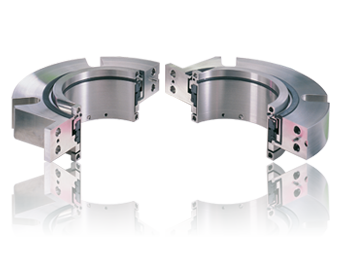Compression packing is used to control water leakage along a pump shaft and to prevent air from entering the process. A packed pump requires substantial power to operate, and every additional ring of packing increases the plant’s energy need. Packed pumps also create hefty demands on water resources to combat the heat generated by friction between the packing and pump shaft. From an energy usage standpoint, a packed pump is a money pit.
Choosing just the right compression packing to seal a pump – while minimizing temperature variances and shaft abrasion – is a tricky process at best. Once a compression packing has been chosen, you still have to contend with putting it on the pump.
Installing or replacing compression packing is at least a six step process:
- Amassing the proper tools
- Shutting down the pump
- Pulling out the old packing
- Checking the wear of the pump shaft and stuffing box (and repairing any damage before proceeding)
- Installing the new packing
- Restarting the pump.
And don’t forget those tools. They will include a knife to cut the packing, packing hooks to remove the old packing, a flashlight and mirror to assist in finding the lantern ring, items like wood setting blocks or sleeves to seat the packing and packing lubricant to treat the packing before installation. But your work isn’t done yet. Packing demands on-going maintenance to ensure it works properly. And maintenance requires manpower, which comes with a significant price tag.
Packing is designed to degrade with normal use. Compression packing can also fail unexpectedly; notably in cases where the incorrect packing was chosen, the packing was overtightened, pump shaft damage was not repaired before installation of new material, or abrasive materials were not effectively flushed. And when the packing fails, the process of choosing and installing the correct material begins all over again!
Compression packing may initially appear inexpensive but when all the associated costs are tallied, packing is considerably more expensive over time than the installation and operation of a mechanical seal.
Flexaseal’s Style 85 and 85M Fully Split Cartridge Mechanical Seals address all these concerns associated with compression packing.
- Easy installation: no measurements. No special installation tools. Simply bolt the two seal halves around the pump shaft by tightening the shoulder bolts, secure cartridge seal to the pump by tightening gland bolts, secure shaft sleeve to the pump shaft by tightening set screws and then remove setting clips.
- Hydraulically balanced seal faces lower heat generation, minimizing the need for excessive water cooling and allowing for a wider range of operating pressures. Balanced seals utilize less than ¼ the resources of standard compression packing.
- The stationary design of the Style 85/85M ensures optimum seal face tracking and alignment. You do not need to constantly adjust the seal due to wear.
- The large diameter cross-section dynamic O-ring slides on a smooth, clean, stationary seal ring surface eliminating pump shaft damage due to abrasion and fretting.
In addition, our Style 85 line greatly minimizes installation guesswork.
- Only two enclosed seal halves are handled. No more juggling multiple items during installation.
- The faces, O-rings, and springs are all encased in the cartridge, protecting them from clogging and corrosion.
- The Style 85 fully split cartridge mechanical seal is completely assembled and pressure-tested at our factory, ensuring sealing integrity and providing a high installation success rate.


